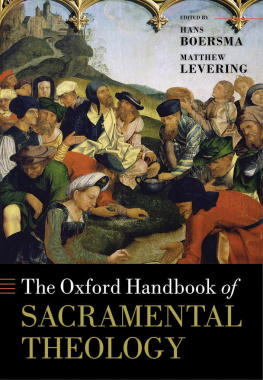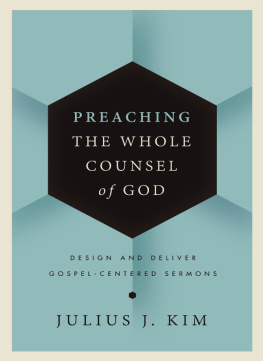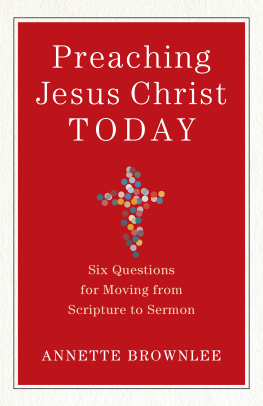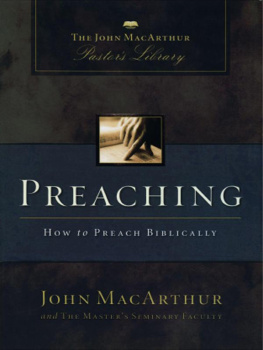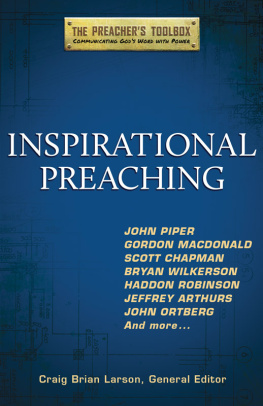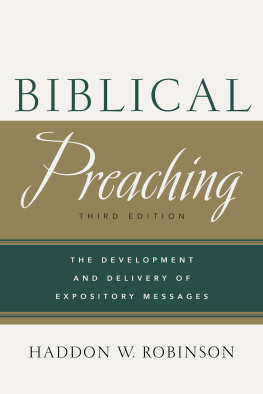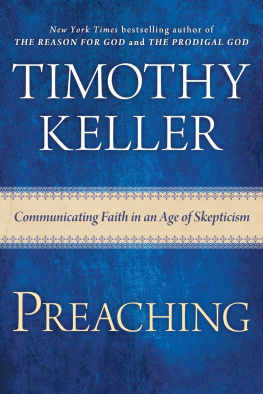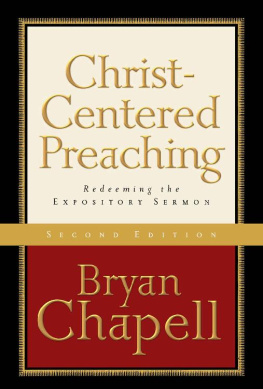Epigraph
Novum in vetere latet et in novo vetus patet.
(The New is in the Old concealed, and the Old is in the New revealed.)
St. Augustine
Scripturae autem divinae sancta profunditas adeo communes sermones habet, ut eam universi incunctanter admittant. Sensus autem recondit veritatis arcano , ut in ipsa studiosissime vitalis sententia debeat indagari.
(Now the holy depth of divine Scripture is expressed in such common language that everyone immediately takes it in. But buried within it are hidden senses of truth, so that the vital meaning must be most carefully sought out.)
Cassiodorus

Contents
Cover
Title Page
Copyright Page
Dedication
Epigraph
Foreword by Eugene H. Peterson
Preface
Introduction
1. Why Join the Chariot?
Acts 8:2635
Part 1: Sensed Happiness
2. First Things First
Exodus 12:112
3. Eat, Drink, and Be Merry?
Ecclesiastes 2:2426; 3:1213, 22; 5:1820; 8:15; 9:7
4. Virgin Mother
Song of Solomon 4:16b5:1a
5. The Blessing of a Child
Exodus 1:12:10
Part 2: Pilgrim Happiness
6. Out of Egypt
Matthew 2:1321
7. Going Up the Hill
Psalm 24
8. Gods Own Rest
Hebrews 3:74:13
Part 3: Heavenly Happiness
9. Happiness in Christ
Psalm 1
10. Resurrection Faithfulness
Luke 20:2740
11. Perfect Blessing
Revelation 22:14
Part 4: Unveiled Happiness
12. The Gate of Heaven
Genesis 28:1022
13. When the Heavens Open Up
Ezekiel 1
14. God of Change
2 Corinthians 3
Epilogue
Subject Index
Scripture Index
Back Cover

Foreword
Sacramental Theology
The pulpit is ever this earths foremost part; all the rest comes in its rear; the pulpit leads the world.... From thence it is the God of breezes fair or foul is first invoked for favorable winds. Yes, the worlds a ship on its passage out, and not a voyage complete; and the pulpit is its prow.
Herman Melville, Moby-Dick
I read those words while at university, and they took root in my imagination and eventually formed a strong sense of identity of myself vocationally as a pastor with a pulpit: Yes, the worlds a ship on its passage out, and not a voyage complete; and the pulpit is its prow .
But in the fifty-five years that I have been a pastor, I havent had many colleagues who share that conviction. What a delight to find a friend in Hans Boersma who does, who believes that the pulpit is its prow and is doing his best to make that believable. This book is evidence of his passion.

The Bible as a whole comes in the form of narrative, what I have come to think of as incarnational storytelling, God revealing himself in human formthe Word became flesh... and we have seen his glory, glory as of the only Son from the Father (John 1:14)and what Hans Boersma designates sacramental storytelling.
Wallace Stegner, deceased but with a still alive reputation as one of our great contemporary storytellers, tells us: if the forms are bad, we live badly. Our Holy Scriptures are a good and true form by which we live well. Storytelling creates a world of presuppositions, assumptions, and relations into which we enter. Stories invite us into a world other than ourselves, and if they are good and true stories, a world larger than ourselves. The story that is Holy Scripture invites us into a world of Gods creation and salvation and blessing, God in human form in action on the very ground on which we also live, an incarnational story , that is, a flesh and blood story, a story worked out in actual lives and places (not in abstract ideas or programs or inspirational uplifting anecdotes), but a Jesus story in which we recognize the action of God in the everydayness of a local history in our stories, a sacramental story.
This idea of sacramental story is important, for a widespread practice in our postbiblical church culture is taking the story and eliminating it by depersonalizing it into propositions or truths or morals or ideas. The story is eviscerated of relationships and persons. Jesus, the center of the Christian faith, is depersonalized into an abstract truth, and men and women are depersonalized into problems to be fixed or resources to be exploited. Eventually there is no story left.
The distinctiveness of what we have learned to name gospel is that it brings the centuries of Hebrew storytelling, God telling his story of creation and salvation and blessing his people, to the story of Jesus, the mature completion of all the stories, in a way that is clearly revelationthat is, Gods self-disclosinga way that invites, more like insists on, our participation.
In some respects this is an odd kind of story, this Jesus creation/salvation/blessing story. It tells us very little of what ordinarily interests us in a story, and we learn virtually nothing about what we are really interested in. There is no description of Jesus appearance. Nothing about his friends, his schooling, his childhood. Very little about what he thought, how he felt, or his interior struggles. There is a surprising and disconcerting reticence in regard to Jesus. We dont figure Jesus out, we dont search for Jesus, we dont get Jesus on our terms. If we stay with the story long enough, we recognize that Jesus and the life he embodies are not consumer items.
Immersion in this gospel world has always been the primary way Christians have developed a sacramental imagination. The first followers of Jesus saw this world take place in their company and before their eyes; they saw the Word become flesh in the humanity of Jesus and actually live among them. Peter was the first to name what they saw and heard as God took human form and over an extended period of time (three years) lived in their neighborhood. Subsequent generations searched the Old Testament, the Hebrew Scriptures, for implicit evidence of the incarnation, Jesus the Christ. But they did not arbitrarily put him there; they found him there. The New was always already present in the Old. Christ himself is hidden in all of the Old Testament. The biblical text is a sacrament, and Christ is really present in it, is Dr. Boersmas summary conclusion.


